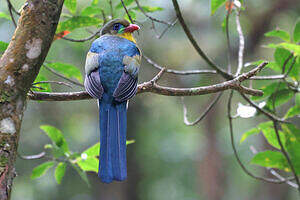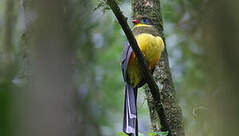Javan Trogon
Apalharpactes reinwardtii - Trogon de Reinwardt
Identification
The Javan Trogon, or Reinwardt's Trogon, of course owes its name to its geographical location, with the scientific name coming from the Dutch naturalist and botanist Caspar Georg Carl Reinwardt (1773-1854). In 1822, Dutch zoologist Jacob Temminck (the field sandpiper!), named this trogon in tribute to Reinwardt. Very close to the Sumatran Trogon, with which it forms the Apalharpactes genus, it is bigger and almost the same colour. A strong orange-red beak and a broad cobalt blue orbital circle surrounding the dark brown iris are unmistakable elements; a yellow-blue protrusion of skin beyond the beak highlights the eye, this protrusion is much more blue in Sumatran Trogons. The head is olive-brown with pale green hues, the throat is yellow and the top of the chest has a wide band of the same colour as the head, the belly is golden yellow and takes on an orange tinge near the wings. The mantle, back and scapulars are green with blue reflections, Reinwardt's Trogon does not have a brown dorsal stripe like the Sumatran Trogon, the green-black coverts are horizontally vermiculated with pale yellow stripes and the remiges are black with very clear white margins. The outer rectrices are anthracite-green tinged with blue metallic reflections, and are framed in white on the edges and ends, the central rectrices are dark green with metallic blue hues. The female is identical to her partner, the yellow colour of the belly is paler and the vermiculations of the coverts are brown-fawn rather than yellow. In both sexes the tarsi are orange. The juveniles have a browner than green hue on the back, the belly is cinnamon spotted with white, the vermiculations of the coverts are brown and white, the beak is orange and the orbital circle is pale blue.
Subspecific information monotypic species
Foreign names
- Trogon de Reinwardt,
- Trogón de Java,
- republicano-de-java,
- Javatrogon,
- jávai trogon,
- Reinwardts Trogon,
- Trogone di Giava,
- javatrogon,
- Blåhaletrogon,
- dravčík modrochvostý,
- trogon rudozobý,
- Blåhalet Trogon,
- jaavantrogoni,
- trogon de Java,
- sędzioł cytrynowy,
- Синехвостый азиатский трогон,
- Luntur jawa,
- キノドキヌバネドリ,
- 蓝尾咬鹃,
- javatrogon,
- 爪哇藍尾咬鵑,
Voice song and call
A trill very similar to the song of the Sumatran Trogon, this one rolls until it ends in churrr-churrr and doesn't have the very high ending note of its close relative from Sumatra: wiwi...wherr-uu. The song remains one of the best ways to identify the far away Javan Trogon, sometimes without even seeing it.
Habitat
Inhabiting the equatorial mountain forests, the Javan Trogon can be found between 900 and 2,600 metres. Just like the Sumatran Trogon, it remains in the lower canopies of trees.
Behaviour character trait
Only sedentary. Javan Trogon (Trogon de Reinwardt) is a bird that does not migrate.
Dietfeeding habits
Reproduction nesting
The breeding period is variable! From April to June, but also in June and August, and young were observed at the end of November. The nest is probably made in the hole of an old tree, often an old woodpecker nest, with usually two eggs; there is no information on incubation and feeding periods of the chicks.
Geographic range
The Javan Trogon is only theoretically found west of Java, across around 1,100 km2, within six mountain forests: Gunung Halimun, Gunung Salak, Gunung Gede-Pangrango, Gunung Patuha-Tilu, Gunung Wayang and Gunung Papandayan. Unfortunately, recent censuses have only located it at three sites: Halimun, Salak and Gede-Pangrango.
Threats - protection
IUCN conservation status
concern
in the Wild
threatened
evaluated
EN: Endangered, at risk! We are facing one of the world's most endangered birds; its original range was 11,600 km2 a few decades ago, now being only 1100 km2. BirdLife believes that the Javan Trogon is in the lowest range, from 250 to 999 adult individuals, which may bring the population to around 1,500 birds with fluctuations of births and predation. The same ills generate the same terrible mistakes: deforestation, human demography (Java is the most populated island in the world with 136 million inhabitants!), anarchic placement of tourist centers, geothermal exploration, etc. How much time do we have left to admire the wonderful Javan Trogon?
Sources of information
- IOC World Bird List (v15.1), Gill, F and D Donsker (Eds). 2025-12-07.
- A Natural history of the Trogonidae, Joseph M.Forshaw Albert Earl Gilbert
- Vol. 6 - Handbook of the Birds of the World, Josep del Hoyo-Andrew Elliott-Jordi Sargatal
- Scientific Birds Names, James A.Jobling
- xeno-canto, Sharing bird sounds from around the world,
- ARKive, Christopher Parsons
- Avibase, Lepage Denis
- BirdLife International, BirdLife International
- HBW Alive,
- Oriental Bird Club,
- IUCN Red List of Threatened species,
- The internet Bird Collection,
- Wikipédia, Wikipedia, The Free Encyclopedia
Other sources of interest
 Specification sheet created on
04/08/2023 by Anne et Gabriel Leboff
Specification sheet created on
04/08/2023 by Anne et Gabriel LeboffTranslation by AI Oiseaux.net
© 1996-2026 Oiseaux.net
- Accipitriformes
- Aegotheliformes
- Anseriformes
- Apodiformes
- Apterygiformes
- Bucerotiformes
- Caprimulgiformes
- Cariamiformes
- Casuariiformes
- Charadriiformes
- Ciconiiformes
- Coliiformes
- Columbiformes
- Coraciiformes
- Cuculiformes
- Eurypygiformes
- Falconiformes
- Galliformes
- Gaviiformes
- Gruiformes
- Leptosomiformes
- Mesitornithiformes
- Musophagiformes
- Nyctibiiformes
- Opisthocomiformes
- Otidiformes
- Passeriformes
- Pelecaniformes
- Phaethontiformes
- Phoenicopteriformes
- Piciformes
- Podargiformes
- Podicipediformes
- Procellariiformes
- Psittaciformes
- Pterocliformes
- Rheiformes
- Sphenisciformes
- Steatornithiformes
- Strigiformes
- Struthioniformes
- Suliformes
- Tinamiformes
- Trogoniformes










